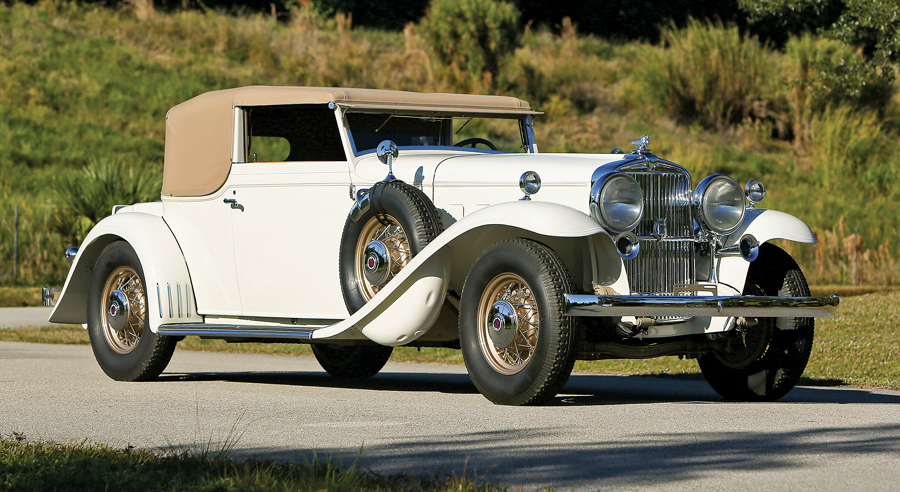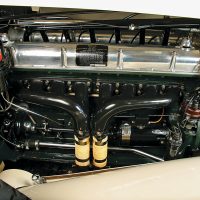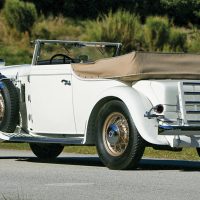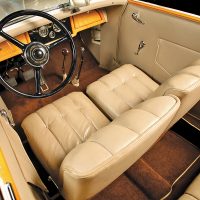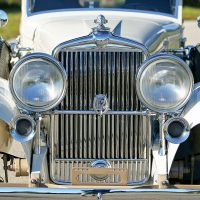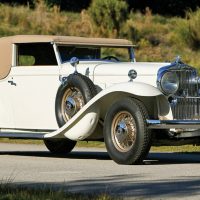SCM Analysis
Detailing
| Vehicle: | 1932 Stutz DV-32 Convertible Victoria by Rollston |
| Years Produced: | 1931–35 |
| Number Produced: | Five Rollston-bodied DV-32 cars |
| SCM Valuation: | $1,100,000 |
| Tune Up Cost: | $2,500 |
| Chassis Number Location: | Right frame rail |
| Engine Number Location: | Left front by head |
| Alternatives: | 1930 Packard 734 Speedster, 1932 Pierce-Arrow Model 53 V12 convertible sedan, 1931–35 Cadillac Series 370A, V12 Roadster |
| Investment Grade: | B |
This car, Lot 277, sold for $863,000, including buyer’s premium, at RM Sotheby’s Amelia Island auction at the Ritz-Carlton on March 9, 2019.
Stutz — “The Car That Made Good in a Day.”
Well, it took more like five weeks, and the car that Harry Stutz and his small crew built for the 1911 500-mile race at the Indianapolis Motor Speedway finished 11th — the first position out of the money.
That was the first-ever Indy 500.
Making a name
In 1910, Henry Stutz, with the backing of wealthy friends, founded the Ideal Motor Car Company. Located in Indianapolis, it was tooled to produce 500 cars per year.
The first one down the production line was sent to the Indianapolis Motor Speedway to participate in the inaugural 500-mile race in 1911. With the initial success, orders poured in and the sporting Stutz became the car to own.
Harry Stutz stated that the objective for his fledgling company was to build the best and fastest motorcar in America. He added, “I want to be remembered as the maker of the best.”
Henry Ford once said that “the way to sell automobiles was to race them,” and race them Stutz did — with Gil Andersen, Earl Cooper and Barney Oldfield often standing on the podium.
However, success was fleeting. Stutz needed additional capital for the manufacture of the new 16-valve engine. So the company’s stock was placed on the New York Stock Exchange. Stutz left the company in 1919.
A stock manipulator gained control of the company in 1920, and the share price was more than $700 at one point. A few years later, the share price fell to $11, and the company filed for bankruptcy.
Stutz’s creditors took over the company and began building safety cars.
With the Great Depression on the horizon, the future was bleak. Stutz debated how to address the multi-cylinder arms race.
It is often stated that Stutz was unable to fund a multi-cylinder motor, but there is solid evidence that their goal was to develop more horsepower without adding additional cylinders.
In fact, the company stated, “The world’s finest cars of this type did not use 12 or 16 cylinders. They used straight-8 powerplants with twin overhead camshafts.”
The Stutz DV-32
The new Stutz DV-32, introduced in 1931, had the same Vertical Eight engine that had first been introduced in 1926 — but with a redesign by Charles “Pop” Greuter.
The new design had twin-overhead camshafts, four valves per cylinder and single spark plugs in polished hemispherical combustion chambers. It was truly an innovative design.
Designated the DV-32, it produced 156 horsepower, which was about the same horsepower-per-cubic-inch ratio as the Duesenberg Model J. It was guaranteed to have done at least 100 miles per hour prior to delivery.
The fabulous design was a wasted effort, and Stutz production ceased in 1935, with fewer than 100 cars produced in 1932 and only 200 DV-32 cars produced between 1931 and 1935.
Our subject DV-32
According to Rollston heir Bill Creteur, five Convertible Victorias were built with this design on the Stutz DV-32 chassis.
Our subject car was found in a Bronx parking garage. It is believed that the owner was killed during World War II.
At one point, the Imperial Palace Auto Collection owned the car. A respected Maine shop restored the car, completing the project in 2001. It went on to win Senior badges in both AACA and CCCA judging.
The restoration, while well maintained, is now almost 20 years old and is no longer fresh. The car sold within RM Sotheby’s estimated range.
According to the SCM Platinum Auction Database, RM Sotheby’s sold a top-notch DV-32 Convertible Victoria by Rollston for $1,100,000 at their 2016 Amelia Island Auction.
In 2013, RM Auctions sold an authentic 1933 DV-32 Rollston Convertible Victoria that was once part of the famed Harrah’s Collection for $1,512,500.
Yes, the market has changed. The 2013 and 2016 sales presented the Rollston Stutz at a premium. This sale at Amelia Island sent our subject car to a new home at a slight discount.
This sale was not a bargain, but it is a solid purchase of an elegant and sophisticated Stutz that will be a treat on a CCCA CARavan or the show field. ♦
(Introductory description courtesy of RM Sotheby’s.)
